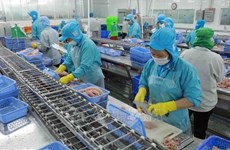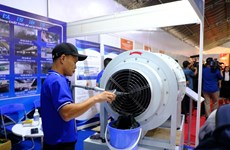Can Tho invests heavily into seafood sector
The Mekong delta city of Can Tho plans to double the area devoted to
aquatic cultivation to 26,000 ha by 2020, according to the municipal
Department of Agriculture and Rural Development.
The Mekong delta city of Can Tho plans to double the area devoted to
aquatic cultivation to 26,000 ha by 2020, according to the municipal
Department of Agriculture and Rural Development.
The target within seven years is a total output of 355,000 tonnes a year and export of 160,000 tonnes of seafood products worth 1 billion USD.
Cultivation areas have been divided into two major zones, one in two districts and on several islets on the Hau River.
It will specialise in blue-legged prawns, tra fish and freshwater fish on a total area of 16,000ha.
The other zone, located in several districts, will breed tra and other fresh water fish in a total area of 10,000ha.
Can Tho authorities have also decided to rotate rice and shrimp cultivation on the same paddy field, or rice and fish.
To meet local demand, the city will set up several aquatic breeding centres that will supply 1-2 billion fries of various aquatic species, including tra and basa fish, anabas, bighead catfish and blue-legged prawns.
The city will also apply advanced farming techniques, and promote Good Agricultural Practises and other food safety hygiene standards in aquatic cultivation to communes.
By 2020, Can Tho expects to have at least 33 seafood processors with a total capacity of 192,000 tonnes of seafood a year.
Can Tho now breeds tra fish and blue-legged spawns on 1,700ha in Vinh Thanh, Co Do, O Mon and Thot Not districts.
This year, the city's Aquatic Cultivation Sub-departments implemented a pilot project to raise male blue-legged prawns on a paddy field in O Mon District's Thoi Hoa Ward.
After six months of raising male blue-legged prawns, Nguyen Huu Huynh, the paddy field's farmer, earned a profit of 40 million VND per hectare.
The model of farming one crop of rice and one crop of blue-legged prawns on a same paddy field per year will help save costs and have higher yields and fewer diseases, according to Huynh.
The pilot model also protects the environment as there is no use of chemicals or antibiotics, he said.
"The development of this model will help farmers increase their income," he said.-VNA
The target within seven years is a total output of 355,000 tonnes a year and export of 160,000 tonnes of seafood products worth 1 billion USD.
Cultivation areas have been divided into two major zones, one in two districts and on several islets on the Hau River.
It will specialise in blue-legged prawns, tra fish and freshwater fish on a total area of 16,000ha.
The other zone, located in several districts, will breed tra and other fresh water fish in a total area of 10,000ha.
Can Tho authorities have also decided to rotate rice and shrimp cultivation on the same paddy field, or rice and fish.
To meet local demand, the city will set up several aquatic breeding centres that will supply 1-2 billion fries of various aquatic species, including tra and basa fish, anabas, bighead catfish and blue-legged prawns.
The city will also apply advanced farming techniques, and promote Good Agricultural Practises and other food safety hygiene standards in aquatic cultivation to communes.
By 2020, Can Tho expects to have at least 33 seafood processors with a total capacity of 192,000 tonnes of seafood a year.
Can Tho now breeds tra fish and blue-legged spawns on 1,700ha in Vinh Thanh, Co Do, O Mon and Thot Not districts.
This year, the city's Aquatic Cultivation Sub-departments implemented a pilot project to raise male blue-legged prawns on a paddy field in O Mon District's Thoi Hoa Ward.
After six months of raising male blue-legged prawns, Nguyen Huu Huynh, the paddy field's farmer, earned a profit of 40 million VND per hectare.
The model of farming one crop of rice and one crop of blue-legged prawns on a same paddy field per year will help save costs and have higher yields and fewer diseases, according to Huynh.
The pilot model also protects the environment as there is no use of chemicals or antibiotics, he said.
"The development of this model will help farmers increase their income," he said.-VNA













